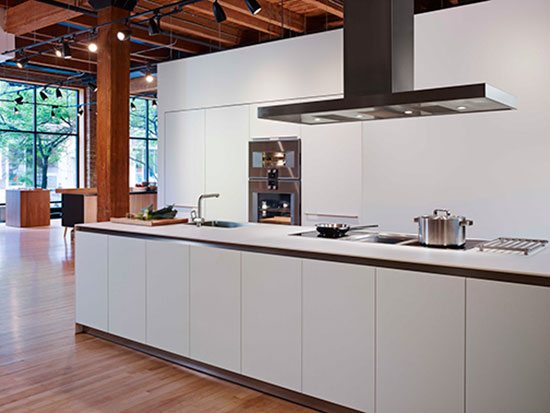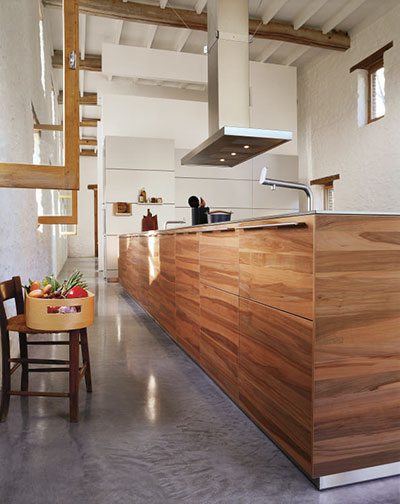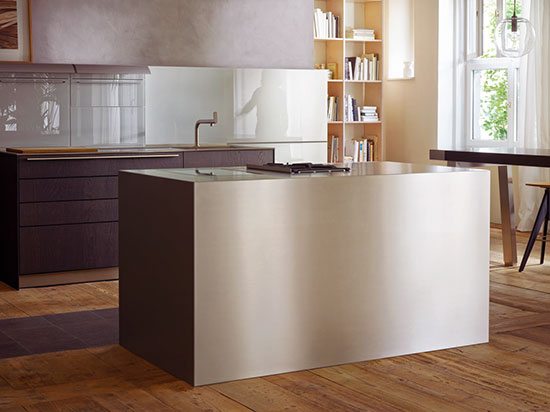Ellen Leslie: Contemporary Kitchen Design in Traditional Spaces
November 20, 2014

Can contemporary, minimalist kitchen design work in a traditional space or home decor scheme? Having designed dozens of kitchens in the New England region, in homes ranging from small lofts to sprawling mansions, this question frequently surfaces.
The answer is, yes. Traditional architecture and decor are abundant in the Greater Boston Area. Modern kitchen design, however, need not detract from this aesthetic preference. In fact, it can provide a much-needed dose of contrast, warmth and functionality to traditional environments.
The first step in designing any kitchen is to think holistically. Rather than having a “Built-in“ mentality, approach the process from a “Built-for“ perspective.
The kitchen‘s look, design and functionality should serve your lifestyle and workflow needs in the present and for decades to come. Work closely with your designer to determine how the space is used day-in, day-out and plan accordingly. Also, think beyond the kitchen to see how your cooking and dining environments relate with surrounding rooms.
One thing to keep in mind about the clean lines of contemporary, minimalist kitchens: the aesthetic and design philosophy is not meant to be trendy. Minimal ornamentation provides a solid visual foundation in the home, and allows for the best use of space. It’s a “form follows function“ approach.
The kitchen should serve the architectural needs of the building. Most visitors—and even future homebuyers—“get it” when they see a well-designed and crafted modern kitchen in a historic or traditional space. The layout and relationship to other architectural elements of the home make sense. The design is timeless.
The large number of high-quality finishes available on the market today makes it possible to match almost any taste and environment. Solid wood and premium wood veneers are very popular in the New England region. Cabinet fronts can be finished in a myriad of wood types/colors and in textures ranging from smooth to rough sawn.
This estate in southwestern France was at one time used as a farm building. Half of the structure was then turned into a communal kitchen with bulthaup cabinets done in planked apple veneer. The finish was chosen because the building stands in the middle of an orchard of fruit trees.

Color options in glossy and matte lacquers are virtually limitless. Then there’s the classic all-white contemporary kitchen. The clean, white lines are elegant, sculptural and unimposing. This allows the rest of the home’s traditional architecture and decor, such as exposed brick and beams, to shine through.
Another approach to blending these two worlds is to create striking visual contrasts in the space. For example I’ve seen people combine precision stainless steel countertops and anodized aluminum cabinet fronts with old, weathered wooden floors. The juxtaposition of „cold“ materials with very „warm“ surfaces creates a surprisingly authentic and welcoming environment.
In this loft space in Munich, Germany a stainless steel monoblock provides a bold but warm contrast to the old wooden floors.

In my opinion, getting attached to just modern decor, just traditional decor, or -for that matter- just transitional decor is never a good idea. The kitchen is for cooking, communicating and enjoying life. The point is to combine whatever makes sense for the well being of you, your family, and home.
Ellen Leslie is a designer at bulthaup Boston, where she works directly with clients, architects, designers and contractors to make functional and aesthetical visions come to life. She has a degree in architecture and has the ability to not only see the beauty of design, but to work through the technical details.
Share
![NEH-Logo_Black[1] NEH-Logo_Black[1]](https://b2915716.smushcdn.com/2915716/wp-content/uploads/2022/08/NEH-Logo_Black1-300x162.jpg?lossy=1&strip=1&webp=1)






